Related Research Articles

Jane Arden was an internationally syndicated daily newspaper comic strip which ran from November 26, 1928 to January 20, 1968. The title character was the original "spunky girl reporter", actively seeking to infiltrate and expose criminal activity rather than just report on its consequences and served as a prototype for later characters such as Superman supporting character Lois Lane and fellow comic strip heroine Brenda Starr, Reporter. Pulitzer Prize-winning columnist Mary McGrory credited Jane Arden with instilling her interest in journalism.
United Feature Syndicate, Inc. (UFS) is a large American editorial column and comic strip newspaper syndication service based in the United States and established in 1919. Originally part of E. W. Scripps Company, it was part of United Media from 1978 to 2011, and is now a division of Andrews McMeel Syndication. United Features has syndicated many notable comic strips, including Peanuts, Garfield, Li'l Abner, Dilbert, Nancy, and Marmaduke.
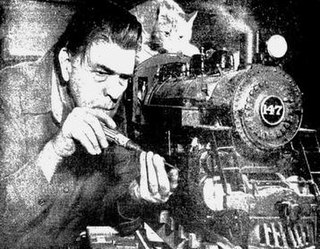
Francis Godwin was an American illustrator and comic strip artist, notable for his strip Connie and his book illustrations for Treasure Island, Kidnapped, Robinson Crusoe, Robin Hood and King Arthur. He also was a prolific editorial and advertising illustrator.
The Los Angeles Times Syndicate was a print syndication service that operated from c. 1949 to 2000. Owned by the Times Mirror Company, it also operated the Los Angeles Times Syndicate International; together the two divisions sold more than 140 features in more than 100 countries around the world. Syndicated features included Pulitzer Prize-winning commentators and columnists, full news and feature services, editorial cartoons and comic strips, online products and photo and graphics packages.

Funnies on Parade is an American giveaway publication of 1933 that was a precursor of comic books. The eight-page publication featured reprints of such popular syndicated comic strips as The Bungle Family, Joe Palooka, Keeping Up with the Joneses, Mutt and Jeff, Reg'lar Fellers, and Somebody's Stenog. Creators included F. O. Alexander, Gene Byrnes, Al Capp, Clare Victor Dwiggins, A. E. Hayward, C. M. Payne, Al Smith, and Harry J. Tuthill.
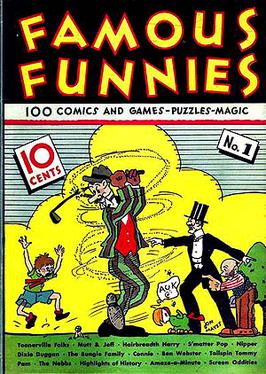
Famous Funnies is an American comic strip anthology series published from 1934 to 1955. Published by Eastern Color Printing, Famous Funnies is considered by popular culture historians as the first true American comic book, following seminal precursors.
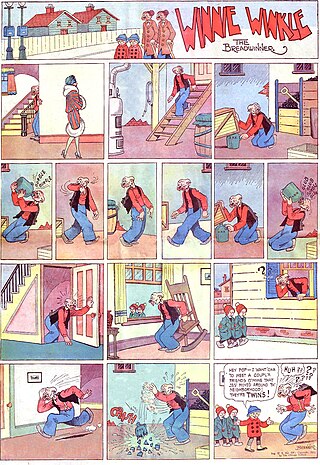
Winnie Winkle is an American comic strip published during a 76-year span (1920–1996). Ten film adaptations were also made. Its premise was conceived by Joseph Medill Patterson, but the stories and artwork were by Martin Branner, who wrote the strip for over 40 years. It was one of the first comic strips about working women. The main character was a young woman who had to support her parents and adopted brother, serving as a reflection of the changing role of women in society. It ran in more than 100 newspapers and translations of the strip's Sunday pages were made available in Europe, focusing on her little brother Perry Winkle and his gang.
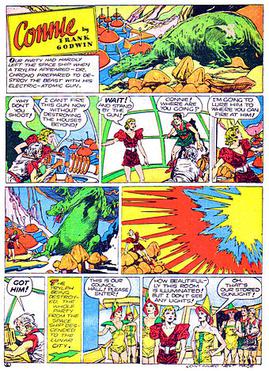
Connie is an American adventure comic strip created by the cartoonist Frank Godwin, who introduced a book illustration style to the comics page. The strip ran from 1927 to 1941 for the Ledger Syndicate. Connie debuted as a Sunday page on November 13, 1927. The strip was syndicated in France as Cora in the weekly paper Le Journal de Mickey.
A comic strip syndicate functions as an agent for cartoonists and comic strip creators, placing the cartoons and strips in as many newspapers as possible on behalf of the artist. A syndicate can annually receive thousands of submissions, from which only two or three might be selected for representation. In some cases, the work will be owned by the syndicate as opposed to the creator. The Guinness World Record for the world's most syndicated strip belongs to Jim Davis' Garfield, which at that point (2002) appeared in 2,570 newspapers, with 263 million readers worldwide.

The McNaught Syndicate was an American newspaper syndicate founded in 1922. It was established by Virgil Venice McNitt and Charles V. McAdam. Its best known contents were the columns by Will Rogers and O. O. McIntyre, the Dear Abby letters section and comic strips, including Joe Palooka and Heathcliff. It folded in September 1989.
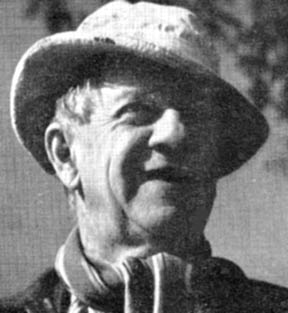
Clare Victor Dwiggins was an American cartoonist who signed his work Dwig. Dwiggins created a number of comic strips and single-panel cartoons for various American newspapers and newspaper syndicates from 1897 until 1945, including his best-known strip, the long-running School Days.
George Matthew Adams was an American newspaper columnist and founder of the George Matthew Adams Newspaper Service, which syndicated comic strips and columns to newspapers for five decades. His own writings were circulated widely to The Gettysburg Times and many other newspapers.

McClure Newspaper Syndicate, the first American newspaper syndicate, introduced many American and British writers to the masses. Launched in 1884 by publisher Samuel S. McClure, it was the first successful company of its kind. It turned the marketing of comic strips, columns, book serials and other editorial matter into a large industry, and a century later, 300 syndicates were distributing 10,000 features with combined sales of $100 million a year.
The Bell Syndicate, launched in 1916 by editor-publisher John Neville Wheeler, was an American syndicate that distributed columns, fiction, feature articles and comic strips to newspapers for decades. It was located in New York City at 247 West 43rd Street and later at 229 West 43rd Street. It also reprinted comic strips in book form.

Alfred Earl Hayward, was a 20th century American comic strip artist. He was known professionally as A. E. Hayward for his comics work although he used his full name for his fine arts work.
The New York Herald Tribune Syndicate was the syndication service of the New York Herald Tribune. Syndicating comic strips and newspaper columns, it operated from c. 1914 to 1966. The syndicate's most notable strips were Mr. and Mrs., Our Bill, Penny, Miss Peach, and B.C. Syndicated columns included Walter Lippmann's Today and Tomorrow, Weare Holbrook's Soundings, George Fielding Eliot's military affairs column, and John Crosby's radio and television column. Irita Bradford Van Doren was book review editor for a time.
The Frank Jay Markey Syndicate was a small print syndication service that distributed comic strips and columns from the mid-1930s to c. 1950. Although small in size, the syndicate distributed strips by a number of notable cartoonists, including Ed Wheelan, Rube Goldberg, Boody Rogers, and Frank Borth. The syndicate also provided material for the burgeoning comic book industry, for companies like Quality Comics and Columbia Comics.
The National Newspaper Syndicate, originally known as the John F. Dille Co., was a syndication service that operated from 1917 to c. 1984. It was founded by Chicago businessman John F. Dille and specialized in comic strips and gag cartoons. It also carried advice columns, such as Paul Popenoe's "Modern Marriage." It is most well known for syndicating Buck Rogers, considered by many to be the first adventure comic strip.
Associated Newspapers, Inc. was a print syndication service of columns and comic strips that was in operation from 1912 to c. 1966. The syndicate was originally a cooperative of four newspapers: The New York Globe, the Chicago Daily News, The Boston Globe, and the Philadelphia Bulletin. Associated Newspapers was led by Henry Herbert McClure (1874-1938), a cousin of S. S. McClure, founder of the McClure Syndicate, the first American newspaper syndicate. In 1930, Associated Newspapers was acquired by and became a subsidiary of the Bell Syndicate. The syndicate's most successful, long-running strip was Gladys Parker's Mopsy.
The New York World was one of the first newspapers to publish comic strips, starting around 1890, and contributed greatly to the development of the American comic strip. Notable strips that originated with the World included Richard F. Outcault's Hogan's Alley, Rudolph Dirks' The Captain and the Kids, Denys Wortman's Everyday Movies, Fritzi Ritz, Gus Mager's Hawkshaw the Detective, Victor Forsythe's Joe Jinks, and Robert Moore Brinkerhoff's Little Mary Mixup.
References
- ↑ Watson, Elmo Scott. "Chapter 10, Bibliography & Appendix, The Newspaper Syndicate in American Journalism. Archived at Stripper's Guide.
- 1 2 Frederic Hudson, Alfred McClung Lee, Frank L. Mott, editors. "The Daily Newspaper in America," American Journalism 1690-1940 (Psychology Press, 2000), p. 594.
- ↑ "Funnies on Parade," Grand Comics Database. Accessed Oct. 29, 2018.
- ↑ Brown, Mitchell. "The 100 Greatest Comic Books of the 20th Century: Funnies on Parade". Archived from the original on 2003-02-24. Retrieved 2003-02-24.
- ↑ Goulart, Ron (2004). Comic Book Encyclopedia . New York: Harper Entertainment. ISBN 978-0060538163.
- ↑ Tye, Larry. Superman: The High-Flying History of America's Most Enduring Hero (Random House, 2012), p. 28.
- ↑ Ages of Heroes, Eras of Men: Superheroes and the American Experience, edited by Julian C. Chambliss (Cambridge Scholars Publishing, Nov 10, 2014), p. 15.
- ↑ "Ledger Signs Huck Finn," Editor & Publisher (Jan. 13, 1940). Archived at Stripper's Guide.
- ↑ Gibson entry, Who's Who of American Comic Books, 1928–1999. Accessed Nov. 23, 2017.
- ↑ Johnson, Gary M., compiler. Content Survey & Selective Index For Editor & Publisher International Year Books: 1929-1949 Library of Congress website. Accessed Oct. 29, 2018.
- ↑ Markstein, Don. "Somebody's Stenog," Toonpedia. Accessed Nov. 30, 2017.
- ↑ Buell entry, Who's Who of American Comic Books, 1928–1999. Accessed Nov. 23, 2017.
- ↑ Cowan entry, Who's Who of American Comic Books, 1928–1999. Accessed Nov. 23, 2017.
- 1 2 3 4 Godwin entry, Who's Who of American Comic Books, 1928–1999. Accessed Nov. 23, 2017.
- ↑ "Charles Coll," Lambiek Comiclopedia. Accessed Nov. 24, 2017.
- ↑ Bowers entry, Who's Who of American Comic Books, 1928–1999. Accessed Nov. 23, 2017.
- 1 2 Cunningham entry, Who's Who of American Comic Books, 1928–1999. Accessed Nov. 23, 2017.
- ↑ Markstein, Don. "Hairbreadth Harry," Toonpedia. Accessed Nov. 30, 2017.
- ↑ Markstein, Don. "Lady Bountiful," Toonpedia. Accessed Nov. 30, 2017.
- ↑ Gage entry, Who's Who of American Comic Books, 1928–1999. Accessed Nov. 23, 2017.
- ↑ Wood Cowan entry, Who's Who of American Comic Books, 1928–1999. Accessed Dec. 4, 2017.
- ↑ Holtz, Allen. "Obscurity of the Day: Modish Mitzi," Stripper's Guide (October 28, 2005).
- ↑ "F.Y' Cory's History as an Artist and Illustrator," F.Y. Cory Publishers, Inc. Accessed Dec. 3, 2017.
- 1 2 Dwiggins entry, Who's Who of American Comic Books, 1928–1999. Accessed Nov. 23, 2017.
- ↑ Jay, Alex. "Ink-Slinger Profiles by Alex Jay: F. O. Alexander," Stripper's Guide (August 11, 2015).
- ↑ Harvey, Robert C. The Art of the Funnies: An Aesthetic History (University Press of Mississippi, 1994), p. 124.
- ↑ Godwin entry, Lambiek's Comiclopedia. Accessed Nov. 26, 2017.
- 1 2 Thompson entry, Who's Who of American Comic Books, 1928–1999. Accessed Nov. 23, 2017.
- ↑ Starrett entry, Who's Who of American Comic Books, 1928–1999. Accessed Nov. 23, 2017.
- ↑ Coll entry, Who's Who of American Comic Books, 1928–1999. Accessed Nov. 23, 2017.
- ↑ Weiss entry, Who's Who of American Comic Books, 1928–1999. Accessed Nov. 23, 2017.
- ↑ Greene entry, Who's Who of American Comic Books, 1928–1999. Accessed Nov. 23, 2017.
- 1 2 "Columnists: Awesome Epigrams," Time (Feb. 09, 1968).
- 1 2 3 Desris, Joe. "A History of the Batman and Robin Newspaper Strip," Batman: The Silver Age Newspaper Comics, Volume One: 1966–1967 (IDW, 2014).